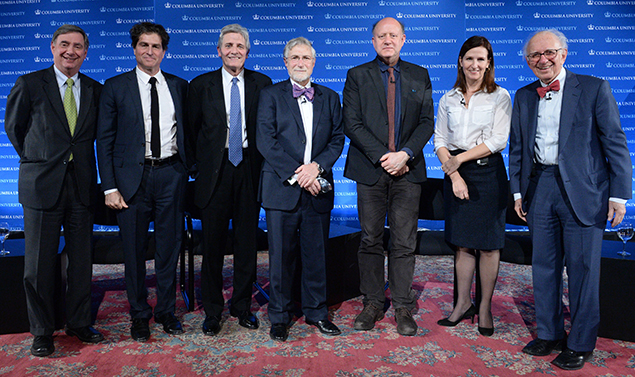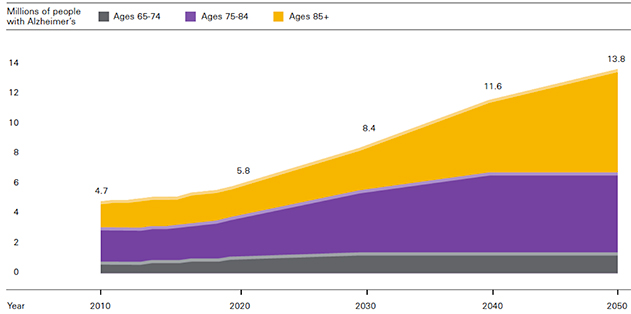Columbia University
Irving Medical Center
Neurological Institute
710 West 168th Street, 3rd floor
(212) 305-1818
Featured Research
The Alzheimer's Disease Research Center at Columbia University Celebrates 25 Years
Earlier this month, leaders from across Columbia University, faculty and staff members from multiple departments, and longtime friends of the University gathered together at the Low Memorial Library for a campus-wide celebration of the 25th Anniversary of the Alzheimer's Disease Research Center at Columbia University. Among those in attendance was the inimitable Dr. Lewis P. Rowland. It was in the late 1980's that Dr. Rowland, then chair of the Department of Neurology, had the foresight to suggest a meeting between Dr. Michael Shelanski—a basic and translational researcher who had made seminal insights into microtubule biology—and Dr. Richard Mayeux—a clinical investigator focused on the epidemiology and genetics of dementia—with the aim of having the two join forces to submit an application to the National Institutes of Health/National Institute on Aging for an Alzheimer's Disease Research Center (ADRC) at Columbia.
 Among those in attendance at the ADRC 25th Anniversary event at the Low Memorial Library this month were, from left to right, CUMC Dean Lee Goldman, and Drs. Scott Small, Richard Mayeux, Michael Shelanski, Thomas Jessell, Karen Duff, and Eric Kandel.
|
At the time, there was a paucity of Alzheimer's disease-related research at Columbia and, certainly, no unified effort dedicated to Alzheimer's disease (AD) and related disorders. Now, twenty-five years later, under the leadership of Dr. Shelanski (founding director), Dr. Mayeux (founding co-director), and Dr. Scott Small (current director since 2013), the ADRC has successfully completed the specific aims of five NIH funding cycles, and was recently awarded a sixth renewal. Along the way, the ADRC has created a nurturing infrastructure to develop career scientists and foster collaboration and innovation across disciplines, become a leader in community outreach, education, and national coordination efforts, and established an ever-expanding local and global network for Alzheimer's disease-related research and development.
At the ADRC 25th Anniversary event, opening remarks from Columbia University President Lee Bollinger and Dean Lee Goldman of Columbia University Medical Center praised the extraordinary, interdisciplinary alliance that has defined the ADRC since its inception in 1989. In addition, a multidisciplinary panel of renowned neuroscience experts—featuring Drs. Scott Small, Michael Shelanski, Tom Jessell, Karen Duff, and moderator Dr. Eric Kandel—discussed past, present, and future discoveries in the field of Alzheimer's disease, much of which could be attributed to the cutting-edge scientific achievements of ADRC investigators.
Prior to introducing this illustrious panel, Dr. Richard Mayeux provided a brief history of the ADRC, describing how Dr. Shelanski and he, a "pathologist-cell biologist-turned pharmacologist and a neurologist-epidemiologist-turned geneticist," agreed in short order that the purpose of the program, from its inception, would be to serve as "a nucleus, an engine, or nerve center for the development of research programs focused on Alzheimer's disease." This guiding principle has served the ADRC ever since, and is what attracted the generosity of Henry and Mickey Taub some years later, prompting the formation of the Taub Institute for Research on Alzheimer's Disease and the Aging Brain. Steven Taub was present at the event, as Dr. Mayeux recalled how his father, Henry Taub, challenged him and Dr. Shelanski to:
Think big, you are not going to solve this problem unless you do.
Leveraging the support from the Taub family and the NIH, the ADRC is now widely considered one of the top centers in the country and can be credited with countless achievements in the field of AD-related research, including:
» The definition of many of the basic mechanisms underlying the cause and consequences of Alzheimer's disease, including current work defining how and when the disease starts, and how and why it progresses; Key elements needed to find the cure.
» Leader of the largest genetic and genomics effort ever attempted for a neurological disorder, with sequencing of the genetic material in 12,000 individuals now completed and several thousand more planned over the next two years, in collaboration with the Institute for Genomic Medicine and the effort in Precision Medicine underway at Columbia University.
» Recognition as THE referral center for dementia in the Northeast United States, with the largest clinical population of any of the 30 NIH/NIA Alzheimer's Disease Research Centers.
» The development of one of the largest brain tissue banks, providing research samples for colleagues all over the world.
» The first ADRC to investigate the cause and devastating effects of Alzheimer's disease on the community, and in African American and Hispanic populations.
» Responsible for the on-going development of a large group of young, independent scientists who have made unraveling the mysteries of age-related neurodegenerative diseases, such as Alzheimer's disease, the major focus of their research.

Drs. Scott Small (left) and Richard Mayeux (right) present Dr. Michael Shelanski (center) with a plaque commemorating his 25 years of leadership of the ADRC.
In 2013, Dr. Shelanski transferred the directorship of the ADRC to Dr. Scott Small. Drs. Shelanski and Mayeux remain co-directors of the Taub Institute. At the 25th Anniversary event, Drs. Small and Mayeux publicly acknowledged Dr. Shelanski's remarkable legacy of ADRC leadership with a plaque commemorating his invaluable "leadership, commitment, and stewardship over the past 25 years." In accepting the award, Dr. Shelanski was careful to note that, "this has been a unique center in the sense that even though the NIH allows only one director…the NIH staff has known for 25 years they could call either me or Richard and count on basically getting the same answer in our working together." Looking forward, Dr. Small intends to build upon the leadership of Drs. Shelanski and Mayeux by redoubling the ADRC's efforts to extend into new technologies, such as neuroimaging, and to further interdisciplinary partnerships, with the goal of solving the complexity of Alzheimer's disease sooner rather than later. As Dean Goldman noted at the event:
At a time when almost every other disease we know seems to be declining…the side effect is that we live longer and more of us develop diseases, of course, of the aging brain. Now, one in nine people over age 65 develop Alzheimer's disease, one in three among people over age 85. For many of us, this is not a matter of if but when. And the impact on the individual doesn't tell the whole story because there is an enormous impact on the family of affected individuals and on their loved ones. It is one of the reasons why I've been so proud here at Columbia to see the extraordinary accomplishments of this program over the years.
Now entering its sixth NIH funding cycle, the ADRC will no doubt continue this great tradition of discovery under the leadership of Dr. Small, with input from the ADRC "Cores" leadership and the External and Internal Advisory Committees. The specific aims of this latest renewal are as follows:
1. To support and integrate the cores and other resources to facilitate research on the relationship between aging and AD, but also to facilitate the research of other diseases that can inform this relationship, including FTD, PD dementia, white matter disease, tangle-only dementia, and diabetes.
2. To foster and expand our multidisciplinary and multi-department 'local network' at Columbia University with a specific focus on better understanding the relationship between aging and AD.
3. To foster and expand our participation in a 'global network' outside of Columbia University, playing active roles in national efforts and consortia that collect clinical, genetic, and neuroimaging data, as well as biospecimens.
4. To support the development of new techniques and methodologies, particularly in delineating the transition from aging to AD, and support the translation of these findings into better diagnostic, prevention and treatment strategies.
5. To foster and expand education and outreach to patients, particularly individuals in the earliest stages of disease, and in the training of young and new investigators.
6. To support three new projects, all led by new investigators, that will focus on better defining normal aging and the transition from normal aging to the earliest stages of AD.
In closing his remarks at the ADRC 25th Anniversary event, Dr. Mayeux summed up the ADRC's impact, as follows:
Where are we now? Therapeutic clinical trials are underway based on the biology of the disease and these treatments will only improve as the growth in knowledge continues. We can now recognize disease in people at risk before overt symptoms are apparent. We can imagine the proteins – amyloid and tau – in the human brain. We have identified most of the key genes involved in causing Alzheimer's disease and are systematically taking each one into the laboratory to understand how these defective genes cause disease and how they interact with other genes or the environment. Advances in pathology and cell biology, biochemistry, genomics and brain imaging are helping us address what has been called the "epidemic of our time".
The mission we started 25 years ago is hardly finished, nor are we. Given the tremendous faculty at Columbia, there is hope for the 6 million people living with Alzheimer's disease and the families who care for them.
 Projected Number of People Age 65 and Older (Total and by Age Group) in the U.S. Population with Alzheimer's Disease, 2010 to 2050.
|
A complete video of the Alzheimer's Disease Research Center 25th,/ Anniversary event at Columbia University's Low Memorial Library on March 8, 2016 can be found on the Columbia Medicine YouTube channel.

